In this time of war, no commercial
airplanes fly into Ukraine. So toward the end of September, I
entered the country from Krakow, Poland by way of a long bus
ride. Crossing the border into Ukraine was slow, but without
complications. The rural area between there and Lviv was green
and idyllic, with a feeling of remoteness from civilization. I
saw a horse-drawn wagon, a sign advertising the New York Balkan
jazz group "PECTOPAH," and a billboard promoting the notorious
Azov regiment. Lviv was a contrast, with the atmosphere of any
other historic Eastern European city.
Having visited Lviv a few years earlier,
I spent a few hours reacquainting myself with the town. I
visited my favorite used-book flea market off Pidvalna Street,
and walked along Prospekt Svobody past the monument to Taras
Shevchenko, the prominent artist and poet who was instrumental
in spurring Ukrainian cultural pride in the 19th century. In the
courtyard by the Greek Catholic Church stood a panel exhibit
devoted to the history of the Holocaust as it had played out in
Lviv. One panel read, "We Remember," in large captions. Most of
the Jewish population of 110,000—almost a third of Lviv's
inhabitants—perished during World War II. The Lviv wartime
ghetto was one of the largest in all Europe.
I caught up with friends I had met a few
years earlier, and other people I met via social media. As I was
walking in the old section with my friend Artem, we saw a man
across the street, yelling to an imagined crowd. No one paid
attention to him. Artem explained that he was citing the Bible
and blaming "the Jews" for Ukraine's troubles.
I had visited Ukraine with my brother in
2019, not long after Volodymyr Zelensky was elected President.
Among other things, we traveled to Zaliztsi, a couple of hours
east of Lviv. Our grandmother had grown up there and emigrated
to the United States before World War I. That western part of
Ukraine, Galicia, had been ruled by the Austro-Hungarian Empire
since the late 18th century. Fifty years after her arrival in
the US, my grandmother still said that she had come from
Austria.
I tried to imagine my grandmother as a
girl, playing in that town when it was a Jewish shtetl. But
there was next to nothing recalling the rich Jewish life of
Zaliztsi, save a severely desecrated cemetery and a charmless
brick house commemorating some local sages of yore, built by
Israeli donors. I was glad that my grandmother escaped all this
history. Even before the Holocaust, there was extreme cruelty
perpetrated against the Jewish population during World War I,
just a few years after my grandmother left.
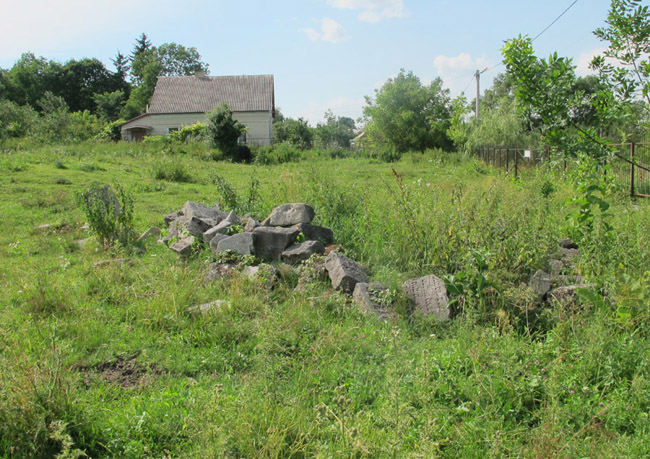
Remains of Jewish cemetery in Zaliztsi
In the course of visits to several
Ukrainian cities this year, I saw monuments to one war after
another, going all the way back to the Cossack rebellions of the
17th century. I pondered what it must be like for a person
growing up in Ukraine to be confronted every day with this
testimony to recurring violence in one's homeland. The trauma
associated with these events continues, obviously, to this day.
One friend, still distressed after the bombing of Lviv that took
place early in Russia's spring 2022 escalation, is reluctant to
venture more than a few blocks from home.
During visits with friends, I regularly
encountered expressions of patriotism and fervor for the defense
of Ukraine against the Russian assault. I heard of a musician, a
woman whose talent was so valued that she was offered a
sponsorship to immigrate to the United States. Instead, she
joined the army and went to the front. My friend Oksana told me
how her husband, over 50 years old, had been mobilized into the
defense. He was old enough to have served in the Soviet army.
Oksana laughed wryly as she noted that due to this background,
her husband was required to take an oath of loyalty to the
Ukrainian army.
Oksana commented, “I feel so sorry that
the blossom of our nation is away fighting and being killed; I
don’t have the words to express my gratitude to the boys and
girls who are out there protecting me.” When I brought up the
proposal of negotiations with the Russians, regularly suggested
by people who are distant from the war. Oksana countered,
“Negotiations with whom? With a crocodile?”
In early October there was the Jewish
harvest celebration of Sukkes, and I went to the Jewish
community center for an observance of the holiday. Other
visitors were present from abroad; there was food, song, and a
good bit of talk by the rabbi, who wore a camouflage yarmulke.
I found it disconcerting that the Jewish
community center was located on Stepan Bandera Street. Stepan
Bandera was a Ukrainian nationalist who collaborated with the
Nazis during the early part of World War II. He was one of the
leaders of the Organization of Ukrainian Nationalists, which
fought on the side of the Germans in Ukraine shortly after the
invasion of June 1941. Extreme Ukrainian nationalist members of
the Ukrainian Insurgent Army (OUN) carried out pogroms against
Galician Jews, and massacred Poles in great numbers as well.
Bandera's hope for an independent Ukraine did not last long, as
the Nazis soon arrested and jailed him.
As the Nazis were losing the war in
1944, they released Bandera so that he could help lead a
continued resistance to the Soviet regime that had taken over
the western part of Ukraine. Bandera remained in Germany, and
the resistance was suppressed in the second half of the 1940s.
The KGB assassinated him in 1959. In 2009 a postage stamp bore
Bandera's portrait, and the next year, then-President Yushchenko
proclaimed Bandera a national hero; this measure was marked by
protests in some parts of the country.[1]
A cult of Bandera has carried on
episodically, with more success in some parts of Ukraine than in
others. I noticed a lone red and black flag, the standard of the
OUN, planted near the center of my grandmother's city of
Zaliztsi; today it can be seen in other parts of eastern Galicia
as well. Counter to this reminiscence, in the post-Maidan period
author Marci Shore quoted respondents as saying that "A lot of
people in my [younger] generation don’t know who Bandera is."[2]
Kyiv: grim monuments
I traveled to Kyiv, the capital of
Ukraine. Again, I spent some time re-familiarizing myself with
the city and catching up with friends and new acquaintances. The
grand cathedrals within walking distance of each other in the
upper city, the St. Sophia Cathedral, St. Andrew's Church, and
St. Michael's golden-domed monastery, still shone with their
ancient glory.
The courtyard in front of St. Michael's
contained a striking display of captured Russian military
vehicles including rusted tanks, armored personnel carriers, and
trucks. Visitors had inscribed graffiti on the relics,
commemorating places of resistance and destruction: Bucha, the
Kakhovka dam, Mariupol, Bakhmut, and more. Someone wrote "F**k
Putin,"—a sentiment expressed in many forms in the souvenir
shops of Ukraine.
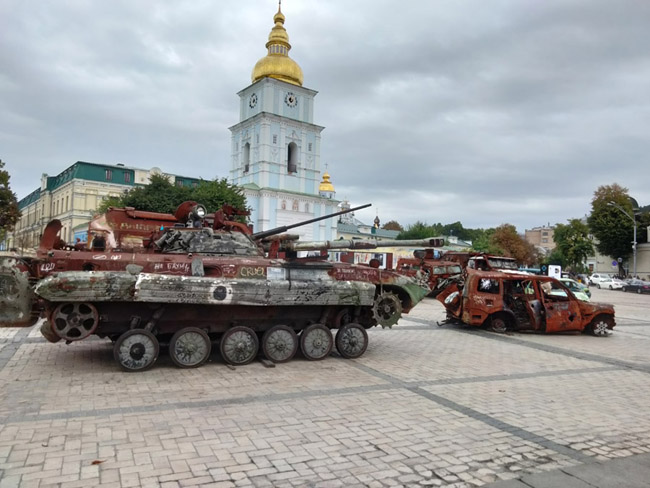
Display of captured Russian war
vehicles in front of St. Michael's Monastery
In a panel display, there was a series
of photos comparing the destruction in various towns of Ukraine
to that of the Warsaw Ghetto. Inscriptions were in Polish,
Ukrainian, English, and German. Details of rubble in the two
locations, more than 75 years apart, were not easy to
distinguish.
I looked around for the prominent statue
of Bohdan Khmelnytsky, which I remembered viewing in the square
by St. Sophia Cathedral, until I
realized that it had been concealed from view by sections of
plywood set up to shield it.
Since Khmelnytsky is such an important
figure in Ukraine's foundational historiography, a bit of
background is important here. He was the leader of the most
successful Cossack rebellion against Polish domination over
Ukrainian lands under the Polish-Lithuanian Commonwealth. The
rebellion, culminating a succession of Cossack uprisings over
the previous century or more, began in 1648. For a time the
Cossacks, first in cooperation with the Crimean Khanate, and
then in an enduring alliance with an ascendant Moscow, carved
out a relatively independent "hetmanate."
This episode on the verge of the modern
era heralded an early upwelling of Ukrainian national sentiment,
particularly as viewed by later historians. Present-day
Ukrainian patriots look back to Khmelnytsky as the closest thing
to a founder of modern Ukraine. However, there were tragic
elements of his movement and its outcome. One was that,
desperate for military assistance to defeat Polish forces,
Khmelnytsky made a fateful pact with Moscow. By the late 1650s
Moscow had conquered Kyiv and much of the eastern part of
Ukraine. At this point, it arranged a détente with Poland, and
the nascent Cossack state was no more.
Another negative aspect of Khmelnytsky's
rebellion was a series of catastrophic massacres of a large
portion of the Jewish population of Ukraine. History-minded Jews
remember these atrocities much more than do Ukrainian patriots.
Estimates of the number of Jews killed range from a very
conservative 20,000[3]
to well over 100,000, with several hundred Jewish settlements
destroyed. This period left the Jewish community of Ukraine
decimated. Among Jews who remember this history, today the
mention of Khmelnytsky, and the Cossacks in general, evokes not
Ukrainian patriotism, but dread.
With the abundance of places named after
Khmelnytsky and Bandera on my mind, I happened to speak with a
Jewish-American friend who is exquisitely conscious of history,
both Jewish and Ukrainian. He said, "The Ukrainians need better
heroes."
Every city I have visited hosts a street
named after Khmelnytsky, and indeed an important city in
Podolia, near Khmelnytsky's base of operations, bears his name.
And in Kyiv, the no-star "Hotel Minimum" where I slept was
conveniently located on Bohdan Khmelnytsky Street.
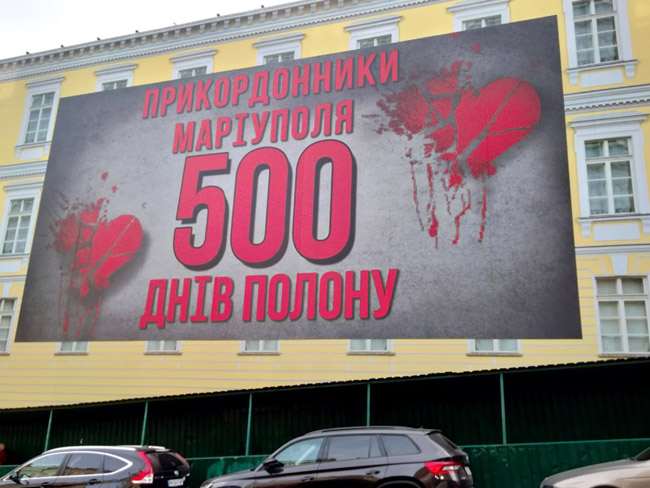
Banner honoring Mariupol resistance
Behind the boarded-up monument of
Khmelnytsky near St. Sophia Cathedral was a massive banner,
easily fifteen meters long and ten meters high, covering up most
of the side of an apartment building, paying homage to the
devastated city of Mariupol. During the ten-odd days that I
spent in the city, I did not hear an air-raid siren as I had in
three other cities I visited, but there had been sporadic
Russian attacks, and there were to be more.
Back toward the center of the city, the
vast Maidan Square still bore mementos to the "Revolution of
Dignity" that took place there in late 2013 and early 2014. Now,
a new layer of commemorative articles has been added. In one
prominent space there are thousands of small Ukrainian flags
planted in the ground, each one commemorating a soldier fallen
defending the country.
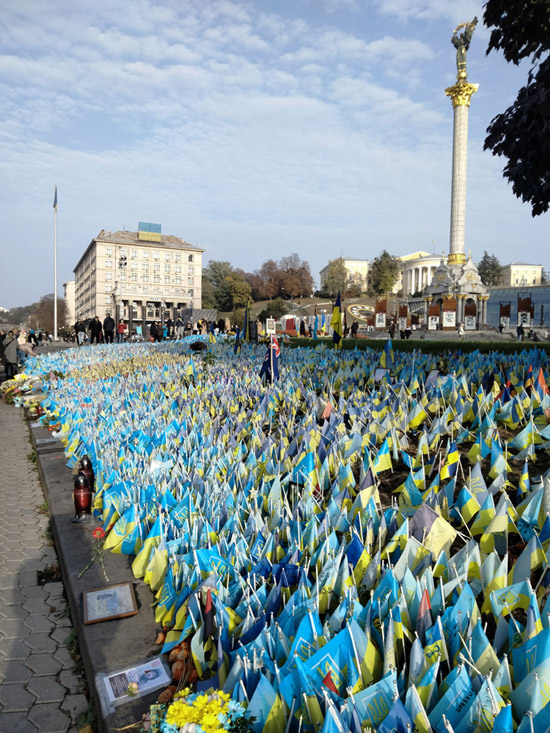
Memorial flags at Maidan Square
In that early part of October, bad news
was coming to Ukraine from a couple of directions. In elections
in neighboring Slovakia, the right-wing populist Robert Fico won
the position of prime minister. He promises to be an ally to
Hungary's autocrat Viktor Orban, who has used his veto power in
the European Union to prevent that body from granting aid to
Ukraine.
At about the same time, in the United
States the Republican-engineered "emergency" budget that
arranged for the continuation of funding for the US federal
government removed $6 billion in assistance for Ukraine defense.
This was just one early move in a series of Republican measures
that will carry on into 2024, holding the US back from supplying
desperately needed military aid to Ukraine.
Working in Hostomel
One day, I joined up with volunteers
from a loose network called "Brave to Rebuild" and traveled to
the nearby town of Hostomel. About fifteen of us, both
Ukrainians and foreigners hailing from Germany, Sweden, Canada,
and many places in between, spent the day removing rubble and
earth from the foundation of a house that had been bombed by
Russian forces in May of 2022.
Hostomel is the northernmost of three
adjacent cities, together with the notorious Bucha and Irpin.
Russian forces attacked all three in late February of 2022, at
the beginning of their full-scale invasion of Ukraine. Bucha
took the brunt of the atrocities, with over 450 civilians raped,
tortured, and killed.
One of the targets of the Russians was
the international cargo airport in Hostomel. They tried to land
at the airport, but Ukrainian forces shot down some of their
helicopters, and bombed the runway so that the Russians could
not use it. This helped to foil the Russians' plan to take over
Kyiv.
The Russians held the three towns for
about two months before being repelled by Ukrainian forces.
Anton, the owner of the house whose foundation we worked to
excavate, told us that Russian forces had occupied his home for
three days. He said that he drank with his uninvited "guests,"
but they also beat him. "It was terrible," Anton said. But he
laughed as he recounted that the soldiers told him, "We will
take Kyiv in three days."
When the Russian troops were driven out
of the area, Irpin was mostly devastated; Hostomel, less so. But
the Russian forces took up position behind the towns and
continued to shell them for the next couple of months. That is
when Anton's house and some other buildings nearby were
destroyed.
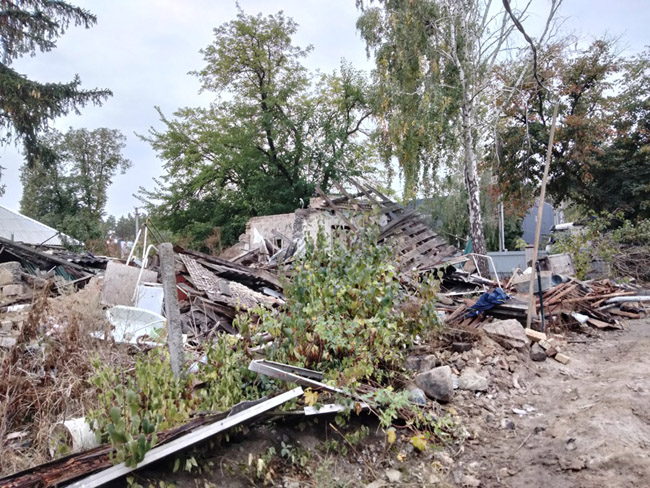 |
 |
|
War
destruction in Hostomel |
Traumatic history with the Russians
The reasons Ukrainians wish to remain
independent from Russia are obvious, as are the reasons for
their resentment of their bigger neighbor. They go much further
back in history than the rape of Bucha in February of 2022. One
event that stands out in that history is the Holodomor, the mass
death by starvation that took place in 1932 and 1933, but had
precursors going back to the early consolidation of Soviet
power. On a free day, I visited the Holodomor Genocide Museum,
up the hill from one of the bridges over the Dnipro.
The museum was housed in one large,
circular room; it was semi-darkened, giving it a somber feeling.
You could walk in one direction around the room and examine a
series of stands pertaining to each oblast (region) of Ukraine.
Each stand held a thick book with the compiled names of those
who starved. One book that I looked at was a thousand pages
long, each page bearing many names of the victims. Displays
around the perimeter of the room described how the Soviet regime
engineered this starvation.
Ukraine is widely known as possessing
one of the richest agricultural lands in Europe, supplying much
of the world with grain. While Lenin had made a gesture to
Ukraine's national identity, his regime took immediate measures
to exploit its agriculture and incorporate it into the Soviet
economy. One display at the Holodomor museum shows a May 1921
telegram from Lenin to military officials reading, "Now the
question for all Soviet power: The matter of life or death for
us is to collect 3-5 million tons [of grain] in Ukraine. We need
to take everything, surround with a triple cordon all the places
of extraction, do not miss a pound, do not allow them to loot.
Let's put things in a military fashion."
Later in the decade under Stalin, and
into the 1930s, pressure on Ukrainian peasants was increased in
the extreme. Stalin enforced collectivization that was
demonstratively counterproductive and targeted peasants, who
resented this move. With the Soviet regime requisitioning
produce and directing it away from the rural areas to the cities
and to Russia, peasants began starving.
Timothy Snyder's book Bloodlands:
Europe Between Hitler and Stalin recounts the Soviet
regime's measures in a detailed, blood-chilling manner. The army
targeted intellectuals and community leaders. A woman was shot
for "stealing" an ear of corn from her own field. People
practiced cannibalism within their own families. In the course
of less than two years, at least 3.5 million people starved. One
sometimes hears figures that are much higher, which could
include starvation regimes that were underway in other parts of
the USSR.
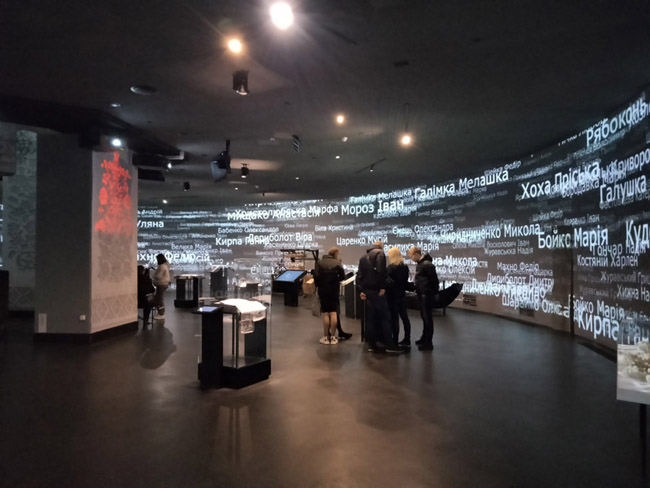 |
 |
| Museum of the Holodomor
Genocide |
Book
of Holodomor victims |
Visiting the scene of another grim
episode in Ukrainian history, I went to the site of Babyn Yar
(Ukrainian—"Babi Yar" in Russian), where the largest Nazi
massacre of World War II took place. The site is within the city
of Kyiv, at the end of the Metro route to Syrets. It is a vast
space, now converted into a memorial park, containing the ravine
where thousands of people were killed and buried. In September
of 1941, Nazi troops massacred nearly 34,000 Jews there. In the
course of the ongoing German occupation of Kyiv, ultimately
between 100,000 and 150,000 Jews, Roma, and Soviet prisoners of
war were killed at this place. The killings went on until late 1943, when Soviet troops
retook Kyiv.
One side of the memorial park is
forested with hardwood trees; in the center of it is a
depression, the ravine where people were killed. There is an
imposing Soviet-built monument in the middle of it on a rise in
the land, dedicated to the "Soviet citizens" who were massacred.
This phrase reflects standard Soviet historiography. While Jews,
Roma, and other Ukrainians suffered the most during World War
II, in the dominant version these groups were elided into
"Soviets."
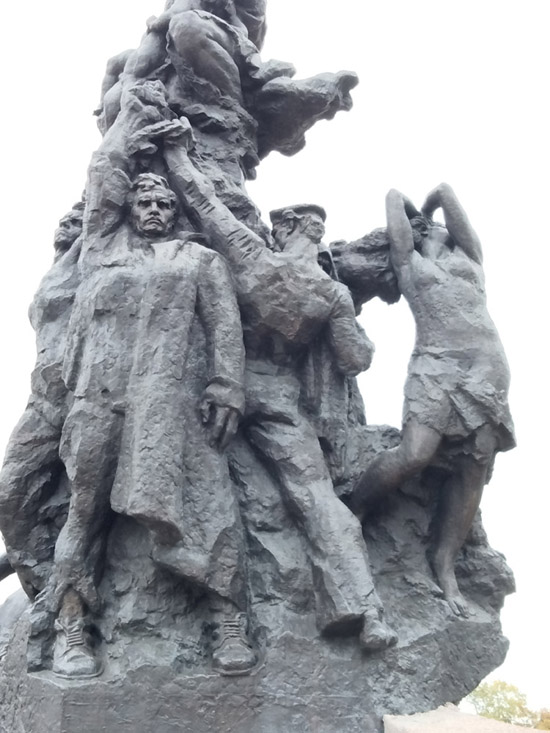
Soviet statue
This falsification of history of the
massacres at Babyn Yar was not addressed until Ukrainian
independence in the early 1990s. It was in that decade that most
of the monuments now seen at Babyn Yar were installed or
re-interpreted. The park was developed into a much richer
memorial, not only to the Jews who were killed, but also to the
victims among the Roma, Ukrainian intellectuals, and Christian
clergy.
In early March of 2022, soon after the
start of Russia's full-scale invasion of Ukraine, Russian planes
bombed a radio tower near the park. They also bombed the
building of the Babyn Yar museum, within the park.
As I was walking, it rained a drizzle. I
remembered what Fata, my landlady in Sarajevo, once said when it
rained on the anniversary of the Srebrenica genocide: "When it
rains, it means that God is angry." I wondered why it only rains
some of the time.
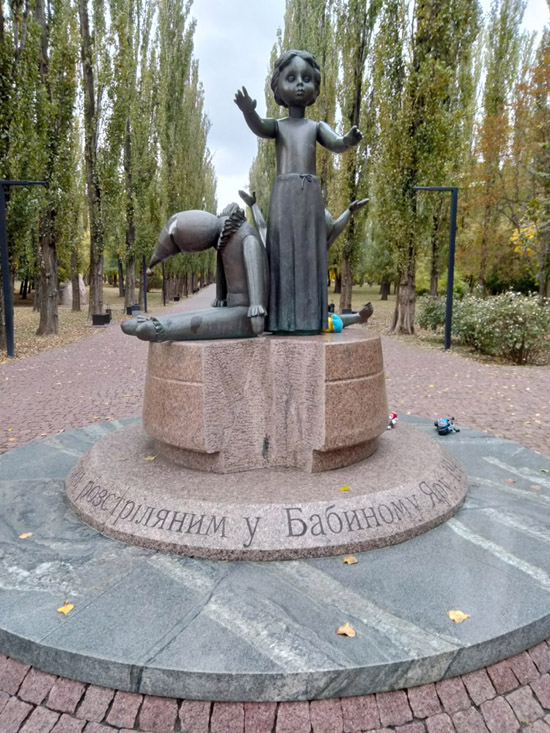
Monument to children victims at Babyn Yar
I arrived at the monument to the
thousands of children killed at Babyn Yar. It was mid-October,
and I couldn't help but think about the hundreds of children
being killed right now in Gaza.
Talking about heroes
It may seem that I went to Ukraine for a
tour of grim monuments, but that is not the case. Rather, I felt
compelled to visit the country as a gesture of solidarity with a
nation that I believed (and still believe) was under a brutal
and unjustified assault from its bigger neighbor. I believed
that Ukraine has a right to defend its sovereignty on the whole
of its land, and that powerful states abroad should help in that
defense—arguably for their own self-interest. I wanted to learn
enough to be better able to approach a variety of questions
posed by those, especially on the Left, who do not share those
beliefs.
I tried to arrange conversations or
interviews with as many people as I could. In addition to
friends and further connections, I had appointments to interview
people working at Karazin University in Kharkiv (see journal
#1). In Kyiv I had the opportunity to meet with two young women
who worked in local corporate offices. I met with Sofia and Anna
at the Honey Café, in the historic center of the city. In this
noisy coffee house we were able to have a wide-ranging
conversation.
I started out by asking the two women
how they viewed the Maidan Revolution that had erupted in
2013-2014, beginning in their own city: "Was that something that
you and your friends were enthusiastic about?" Anna responded,
"We were very young then, but when we see what happened, it had
to do with wanting to be part of the West."
I asked, "What does it mean to you, to
be part of the West?" Anna said, "First of all, having visas to
go to Europe. Before, it was very expensive, and it was very
hard to get visas. The wish of Ukrainians to go to Europe—not
only physically, but culturally and economically, was strong. We
don't want to live the same life as the Russians. We want to
have good jobs, a good level of cultural development of our own.
And Yanukovych, essentially, was saying no to our wishes. It was
obvious that he just wanted to stay on the Russian side."
Viktor Yanukovych was the profiteering
prime minister of Ukraine between 2010 and 2014, when he was
forced by the Maidan protests around the country to flee to
Russia. The protests were in response to his failure, under
pressure from Russia, to sign an association agreement with the
EU. Bitterly disappointed citizens of all ages, classes, and
political persuasions filled the Maidan Square through several
months of freezing weather. In February 2104, the regime's
special police shot around one hundred protestors. This only
intensified the anger of the citizens, and Yanukovych was soon
forced out of office.
Sofia expressed resentment of Russian
designs, saying, "It is as if they, the Russians, consider us to
be like some tribe, that we are not a people. They would like
this all to be Russia, with no border, but we would like to
preserve our independence and our identity. The Russians, they
are more an Asian people than Slavic.
"Before Maidan, when Russian people came
to Kyiv it was always okay. If you spoke Russian, it was ok. We
were speaking Russian until February 2022. In my family, it was
generally our language, because my parents were Soviet people.
And Russians say that Ukrainian is just a dialect of the Russian
language. People were pressured not to use Ukrainian, until
after we got our independence. So many schools, many
universities, held classes in Russian, and many TV shows were in
Russian. Whole generations were raised with this. But now we are
working to be proud of ourselves as people who feel like
Ukrainians. It has been a short time, but the process is now
going faster. We decided to avoid Russian in all areas, for
people who know the Ukrainian language."
Anna added, "About 15 years ago our
government, when Yushchenko was prime minister, decided on a
policy of Ukrainianization. So TV shows started being broadcast
in Ukrainian, and most of the songs on the radio are in
Ukrainian."
Anna spoke about the Russian invasion,
which started in 2014 after the Maidan Revolution. At that time,
Russia quickly moved into an unprepared country and took over
parts of Donbas in the southeast, and the entire Crimean
peninsula.
Not all Ukrainians objected to Russia's
assault at that time. "There was nostalgia among some of the
older people for the Soviet period, because they associated that
time with stability over an uncertain future," Anna said. "But
at the same time, a huge majority of Ukrainians had a strong
historical memory and a sense of grievance against Russia. We
remember Stalin and the genocide of the Holodomor. And we
remember that Ukraine was not always under the domination of
Moscow. This war started 400 years ago; now there is a terrible
escalation, but we hope this will be the last of it."
I asked what happened 400 years ago.
Anna said, "At that time, Poland and Lithuania were one kingdom.
And there was a revolt against Poland and Lithuania by one of
the Cossack warriors, the hetman Bohdan Khmelnytsky. He fought
against Poland for the independence of Ukrainian land. When he
saw that the army of Cossacks was not enough to defeat Poland,
he decided to ask Moscow for military help. At that time, Moscow
was not a big power."
I asked, "Was that a mistake?" Sofia
answered, "Oh yes, it was a very big mistake, because in that
way, he gave power over Ukraine to Moscow."
That was in the mid-1600s, and by a
couple of generations later, Moscow had become the center of an
empire with domination over the traditional Ukrainian lands.
This domination was compounded over the centuries. For example,
many Russians were moved into depopulated parts of Ukraine,
especially in the southeast, after the Holodomor.
Sofia and Anna lamented the destruction
accompanying Russia's full-scale invasion of 2022. Sofia
recalled, "At the beginning, Kyiv was empty. Shops were closed,
and many of our friends left. We both stayed here, because we
wanted to help in the defense of our country. And we didn't know
what was happening. We only found out about things like Bucha
much later, in April. We knew that the occupation army was
there, but we didn't even imagine what they were doing.
"They are killing people in places like
Izum, and in the Kharkiv region; and it was terrible to see what
happened in Mariupol, with just insane numbers of civilians
killed. And they are taking Ukrainian soldiers and beating and
killing them. It is genocide."
I noted, "Genocide is a UN Convention;
it means something specific. It means to harm intentionally, in
whole or in part, an ethnic, religious, or racial group by
causing physical or mental injury or, among other things, by
taking the children away."
Anna: "You see how many children were
taken away and given to Russian families."
"Now," she said, " I would like to go to
the front, but I can't. But I can stay and help here."
"We see that the US is wavering on the
subject of military aid to Ukraine. Are there many people in the
USA who support Trump, and say you shouldn’t help Ukraine? It is
a very dangerous situation, with Russia getting weapons from
China and other countries. So to protect ourselves, we need to
have our own weapons manufacturers, our own weapon supply.
Because we can't just keep asking every country for help and
money. We will have to have more of an arms industry."
I commented that there are people in the
West who advocate early negotiations between Ukraine and Russia,
and that the US should stop sending weapons to Ukraine. Sofia
asked, "What will you negotiate?" I admitted that I had not
heard any concrete suggestions. Sofia responded, "Unfortunately,
that is not a solution, because 'negotiation' just sounds like
leaving the situation as it is, changing the map of Ukraine.
There should be no changes like that."
Sofia and Anna had heard that there were
large numbers of Russians entering Poland and other parts of the
European Union, without obstacles to their immigration. Anna
said, "It is not acceptable to allow Russians to move to other
societies. They come to another country, and they aren't able to
learn a new language, and they aren't able to make use of being
there. Meanwhile, Ukrainians are having difficulty emigrating to
the US."
I pointed out that many of these
Russians in exile are people who don't agree with Putin.
Sofia: "Why don't they do something to
remove his power, or his money? It's a country of 140 million
people, but they are afraid. What should I do? They are afraid,
but we are dying because of them. It's their problem."
I answered, "There are people who tried
to protest, and now they are in jail for 15 years, for as little
as a comment on social media."
Sofia: "It is their country. They have
to do something. We took care of Yanukovych; we organized and
forced him to leave."
I responded, "Slava Ukraini," and moved
on to another question.
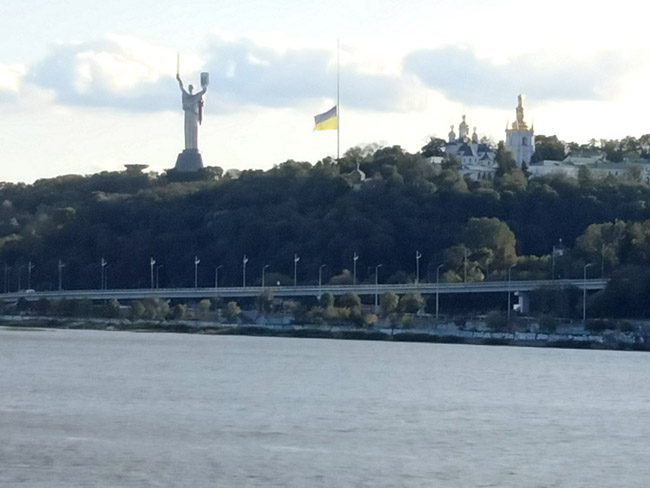
Monument to Mother Ukraine above Dnipro River
I asked, "I'm wondering who would you
and your friends say your heroes are, now, or in history?"
"Now," Sofia said, "my heroes are the
soldiers on the front, and the people who stayed here in Kyiv,
and didn't leave. They stayed here to help."
Anna added, "Another hero I would
mention, from the past, is Stepan Bandera, who fought more than
70 years ago, fighting the Russians. But a Russian agent killed
him. The KGB, they killed him in Germany."
"So he’s a hero?" I asked.
Anna, "Yes, he’s one hundred percent a hero. The identity of the
Ukrainian people is related to his history. He promoted the idea
of an independent Ukraine. He was ready to die for an idea, for
Ukraine."
I said, "I have heard of this, but also
that he collaborated with the Germans."
Anna said, "It was just in the start of
World War II, because they had no information about what the
German army was going to do in the war, but they were ready to
collaborate with anybody against the Russians. They knew what
the Russians would likely do to us, but they didn’t know what
the Germans were going to do. The Red Army was much more
aggressive here. My grandparents said they expected that if the
German army came to Ukraine, they weren't going to kill people.
It was just, 'Okay, they occupied here.' Most of Ukraine hated
the Soviet government; they hated the things they had done here
in the last ten years before the war. There was not much choice.
You could go with the Red Army, or you could go with the German
army."
As I ponder these words, trying to
receive them without judgment, I remember that most of America's
currency and coinage glorifies slave owners and Indian killers.
It is the same with our streets named after Washington,
Jefferson, Jackson, not to mention Jefferson Davis and Robert E.
Lee, just now experiencing a bit of revision in the South. And
our heroes are not only symbolic; they are in our minds. We need
a Revolution of Dignity, and better heroes, here in the US as
much as anywhere.
I'm not sure if anyone consciously
chooses to be a hero. However, the look of it is that Ukraine is
getting thousands of new heroes today, perhaps better ones. I
fervently hope that their sacrifice is recognized and that it
will prove to be worthwhile.
[1] "A Fascist Hero in Democratic
Kiev," by Timothy Snyder, New York Review of Books,
February 24, 2010
[2] p. 47, The Ukrainian Night: An
Intimate History of Revolution, by Marci Shore (Yale
University Press, 2018).
[3] p.
99, The Gates of Europe: A History of Ukraine, by
Serhii Plokhy (Basic Books, 2021)